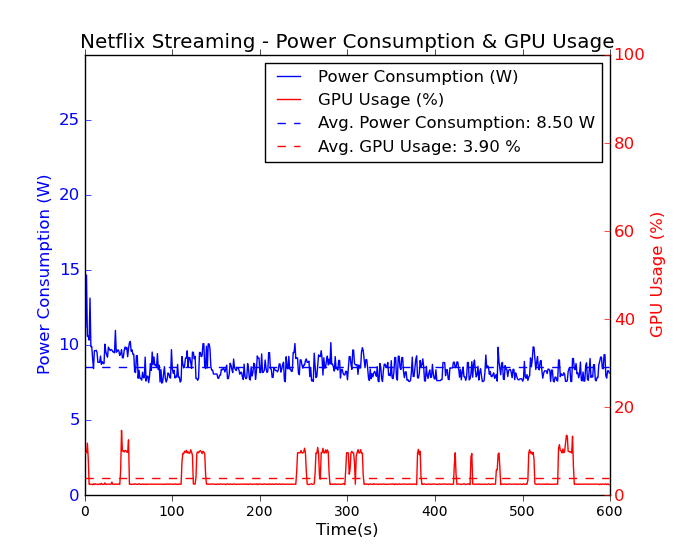Intel's Haswell NUC: D54250WYK UCFF PC Review
by Ganesh T S on January 3, 2014 4:25 PM ESTNetworking Performance and Streaming Aspects
In this section, we will take a look at the networking capabilities of the unit and also our standard HTPC streaming tests (involving YouTube and Netflix). Starting with this review, we are standardizing our evaluation of the wireless networking capabilities of UCFF and industrial PCs. Our standard test router is the Netgear R7000 Nighthawk configured with both 2.4 GHz and 5 GHz networks. The router is placed approximately 20 ft. away, separated by a drywall (as in typical US buildings). A wired client (Zotac ID89-Plus) is connected to the R7000 and serves as one endpoint for jPerf evaluation. The UCFF PC is made to connect to the two wireless SSIDs and jPerf tests are conducted for both TCP and UDP transfers with pre-set transfer parameters.
In our NUC build, Intel's Dual-Band Wireless-7260 delivers 2T2R 802.11ac speeds and provides very good throughput numbers when used with an appropriate router. As the gallery below shows, the 2.4 GHz band is able to deliver TCP throughput in the region of 86 Mbps and UDP throughput in the region of 96 Mbps.
The theoretical bandwidth number for 2x2 802.11ac is 867 Mbps. Practically, in the 5 GHz band, the 7260's TCP throughput is around 210 Mbps and UDP throughput is around 239 Mbps in our test setup.
Network Streaming Performance - Netflix and YouTube
YouTube and Netflix are two very popular streaming services utilized on HTPCs. With Windows 8, Silverlight is no longer necessary for Netflix streaming. The Netflix app on Windows 8 supports high definition streams (up to 5.8 Mbps) as well as 5.1-channel Dolby Digital Plus audio on selected titles.
It is not immediately evident whether GPU acceleration is available or not from the OSD messages. However, GPU-Z reported an average GPU utilization of 4% throughout the time that the Netflix app was playing back video. The average power consumption was around 8.5 W. Coming it at less than 10 W for the whole system while streaming HD video is very impressive. The spikes in the GPU usage were observed whenever the subtitles or control OSD kicked in. There is obviously some correlation between these spikes and the recorder power consumption at the wall.
One of the issues that I faced with the Netflix app was that bitstreaming HD audio (Dolby Digital Plus) would just not work. The playback was jerky to the point of being unwatchable and with either no or intermittent audio output to the AV receiver. Apparently, this is an issue faced by multiple users, and the problem stems from the Intel Display Audio Driver. Intel's rep on the forums, however, has been unable to reproduce the issue. So, it looks like many users are being left high and dry, unable to take advantage of one of the most important aspects of running Netflix as a Metro app.
Unlike Silverlight, Adobe Flash continues to maintain some relevance right now. YouTube continues to use Adobe Flash to serve FLV (at SD resolutions) and MP4 (at both SD and HD resolutions) streams. YouTube's debug OSD indicates whether hardware acceleration is being used or not.
Despite Windows 8 having plenty of YouTube apps, the browser interface is pretty much functional and free of external intrusive ads. The graph below shows the power consumption and GPU loading when playing a YouTube video in full screen using the Adobe Flash plugin on Mozilla Firefox.
The average GPU load is pretty constant around 8%, but power consumption at the wall has spikes corresponding to bursts of network activity. These bursts die down towards the end, after the full video gets buffered.
We saw that Haswell provided great power benefits for such network streaming activities in our HTPC piece at launch time. The Intel NUC takes this power benefit one step further by using a ULV processor. With a power consumption of less than 10 W for these activities, we are approaching dedicated media streamers' territory with the added flexibility of a full-blown PC at one's disposal.




















107 Comments
View All Comments
elian123 - Sunday, January 5, 2014 - link
Definitely interested in thermals of Brix Pro. Where the Brix's U-series CPUs have 15W TDP, the Brix Pro's R-series CPUs have 65W.DanNeely - Saturday, January 4, 2014 - link
MY assumption is a combination of limited production capacity, and/or too much power consumption to put it anywhere except the top of the product range. It's currently only on 47W TDP models; estimating it's share of the total TDP isn't easy because the best match for the CPU in the fastest Iris pro is a 37W part while the best match for the CPU in the slowest IRIS pro is a 17W model. While there's probably differential binning going on, it suggests that a lower performing IRIS ram chip is a power pig.bobbozzo - Friday, January 3, 2014 - link
You can find fanless (aluminum) NUC cases.Unless Silvermont is much cheaper, I don't see the point as performance (CPU, maybe GPU too) will be much worse.
bobbozzo - Friday, January 3, 2014 - link
Patterson, there's lots of fanless NUC cases; many are quite small.see http://www.fanlesstech.com/search/label/TRANQUIL%2... for examples.
patterson32 - Saturday, January 4, 2014 - link
Ya but the ones I like cost too much compared to the total system cost. That's why I'm trying to see if there are any quieter fan replacements instead.jason64 - Saturday, January 4, 2014 - link
Many of the good small ones need to be imported for US customers which just adds to the already high cost. At least for me anyway. I don't mind going with a quieter fan solution as long as the noise doesn't annoy me especially when watching movies.bobbozzo - Friday, January 3, 2014 - link
Hi Ganesh,1. Any hope of this thing doing 4k video?
What about the BRIX with Iris Pro?
2. how loud is it when playing movies?
3. how loud is it idle?
Thanks for the reviews!
Alketi - Saturday, January 4, 2014 - link
It's silent at IDLE.It's unnoticeably quiet for me when playing 1080P bluray rips (sitting 8-10 feet away).
And, regarding 4K -- my best advice, which I read myself as I had the same concern -- buy a new $400 toy when 4K finally becomes mainstream and you have both the content, and a television, and an HDMI interface, and a receiver to play them with. Don't worry about future-proofing a sub-$500 item. :)
ganeshts - Saturday, January 4, 2014 - link
Yes, this can do 4K video to the extent of what other GPUs from AMD / NV can do. I am not so sure about very complicated 4K encodes. We plan to standardize our 4K HTPC evaluation in Q3 when HDMI 2.0 (4Kp60-capable) sources and sinks come into the market.Fan noise is only an issue if you are using it as an office machine and sitting less than 3ft away from it (and that too in a quiet environment). This issue is there at idle too.
If you are 3ft. or more away, I don't think it is even possible to hear the fan :)
chizow - Saturday, January 4, 2014 - link
Still too pricey imo for what it is and what it is limited in doing. I was wondering why a rash of sales popped up on the last-gen NUC with i3 + Thunderbolt today, on sale at a variety of places for $160. That is what I am looking to pay for one of these units given the fact you still need to buy RAM and an mSATA. I wonder if Intel would introduce a cheaper Atom version as Atom seems to be the cure for all Intel-price-related woes. :DI was hoping this updated version corrected the biggest downside of the original, the requirement of mSATA but it only looks like the pricier WYKH SKU allows for full 2.5" SSDs. I have plenty of those in the 120-128GB range so I'd rather not spend another $120 or so on a similar sized mSATA drive. Also, Intel still not including a mickey-mouse power cable is ridiculous, it really feels like they are doing everything they can to not sell these things.